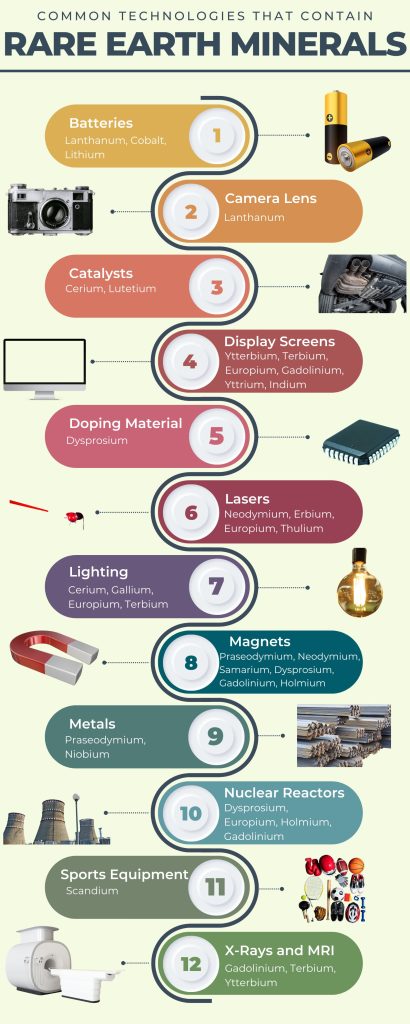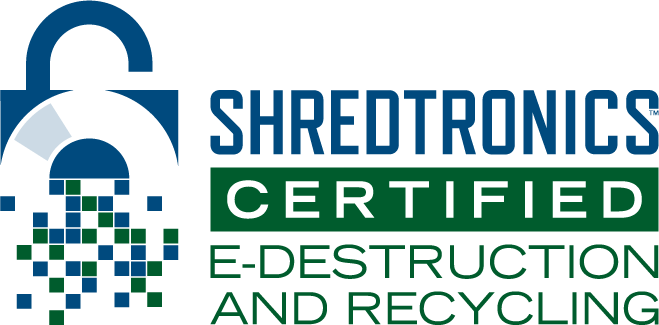
Rare earth minerals, also known as rare earth elements (REEs), are a group of 17 elements. Their unique chemical and physical makeup allows them to provide magnetic, heat-resistant, and phosphorescent properties that other elements cannot. They are crucial for modern technologies, especially in the energy, defense, and electronics sectors, making them highly valuable. Below are some of the common ways that we use rare earth minerals.
Common Uses of Rare Earth Minerals
Electronics
Screens, cameras, and speakers rely on rare earth minerals such as neodymium, praseodymium, and dysprosium. Phosers containing rare earths, such as europium and yttrium, are used in LED and plasma TVs. In addition, neodymium is used in powerful magnets found in hard drives.

Renewable Energy
Neodymium and dysprosium are key in producing strong permanent magnets for the electronic generators in wind turbines. Rare earth minerals like neodymium, terbium, and dysprosium are used in electronic motors.
Defense and Military
Rare earths like samarium are used in precision-guided missile systems, while neodymium is used in lasers for targeting. Yttrium and other rare earths are used in materials that withstand high temperatures in aircraft engines.
Medical Devices
Rare earth magnets are crucial for the powerful imaging capabilities of MRI machines. Gadolinium is used in X-ray and MRI contrast agents.
Lighting and Optics
Elements like europium and terbium are used in compact fluorescent lights (CFLs) and LED lights. Rare earths improve the refractive index and other properties in specialty glasses and lasers.
Catalysts and Batteries
Rare earths like lanthanum are used in catalysts to refine crude oil into gasoline and diesel. Cerium is used in catalytic converters to reduce emissions from vehicles. Furthermore, rare earth elements such as lanthanum are found in hybrid cars and are essential for these batteries.
Issues Involving Rare Earth Metals
Environmental Impact
Mining brings up environmental concerns such as land degradation, pollution, and negative impacts on wildlife. Concerns also stem from the waste products (tailings) created through the refining process. Tailings can be hazardous and radioactive and yet they are often dumped into local water supplies.
Global Shortage
China is responsible for about 95% of the REE processing globally. When they attempted to restrict the supply of REEs, it was a major cause for concern in other industrialized countries. Japan, for example, relies on REEs to produce catalytic converters for the automobile industry, which is the mainstay of their economy.
When the COVID-19 pandemic caused disruptions in China’s rare earth sector, concerns increased. Product shortages filtered down the supply chain and revealed our dependence on REEs.
Preservation
Technological demands will only increase in the coming years and beyond. To ensure adequate supplies of REEs will be available, the US is exploring other resources. Developing more American-based REE mines, recycling REEs, and finding substitute materials for REEs are efforts in the works.
Lastly, effective REE recycling has the most potential benefits. Recycling would decrease the demand for mining and lower the negative environmental impacts. It would also mean avoiding the expensive steps of separating low-value REEs from high-value REEs. E-waste recyclers could recover both precious metals and rare earth metals, offsetting costs and improving sustainability.
Protect Earth’s Resources with Electronics Recycling
ShredTronics will connect you with e-waste recycling companies near you. We responsibly dispose of computers, smartphones, and other devices to promote sustainability and protect the planet. Give us a call at (844) 648-4908 or fill out the form and we will send you free quotes on electronics recycling services within minutes.











